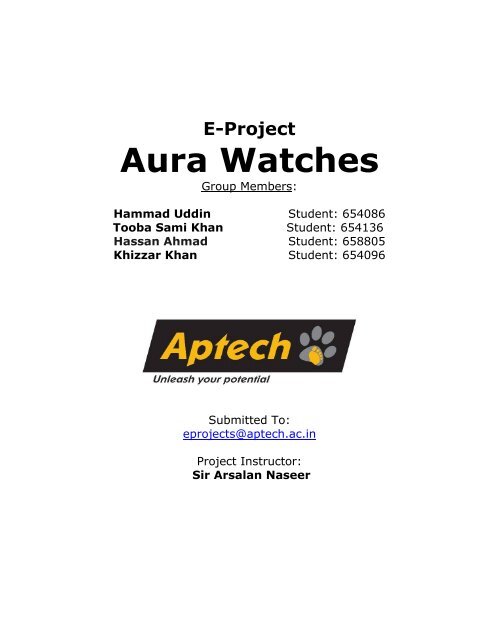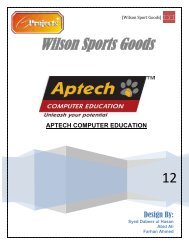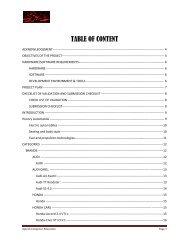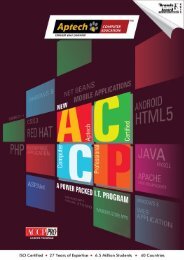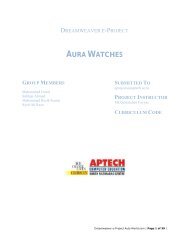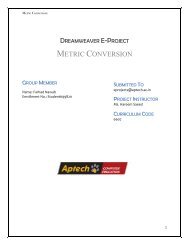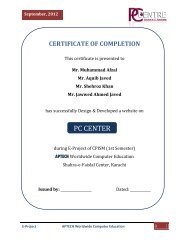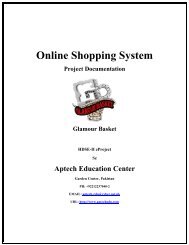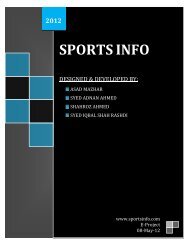Aura Watches - Aptech Computer Education
Aura Watches - Aptech Computer Education
Aura Watches - Aptech Computer Education
Create successful ePaper yourself
Turn your PDF publications into a flip-book with our unique Google optimized e-Paper software.
E-Project<br />
<strong>Aura</strong> <strong>Watches</strong><br />
Group Members:<br />
Hammad Uddin Student: 654086<br />
Tooba Sami Khan Student: 654136<br />
Hassan Ahmad Student: 658805<br />
Khizzar Khan Student: 654096<br />
Submitted To:<br />
eprojects@aptech.ac.in<br />
Project Instructor:<br />
Sir Arsalan Naseer
PROJECT CERTIFICATION<br />
This is to certify that,<br />
Mr. / Miss.<br />
Khizzar Khan Student: 654096<br />
Hassan Ahmad Student: 658805<br />
Hammad Uddin Student: 654086<br />
Tooba Sami Student: 654136<br />
Has successfully Designed & Developed<br />
<strong>Aura</strong> <strong>Watches</strong><br />
Submitted by:<br />
Khizar khan<br />
Hassan Ahmad<br />
Hammad Uddin<br />
Tooba Sami<br />
Date of Issue:<br />
14th march 2013<br />
Authorized Signature: Sir Arsalan Naseer
ACKNOWLEDGEMENT:<br />
Praise is to Almighty Allah who taught us that we knew not. All thanks to our<br />
Omnipotent Lord, for providing us with opportunity and ability to commence, explore<br />
and eventually complete the report of the project.<br />
We take this special occasion to thanks our parents. We dedicate this work to<br />
our parents. It would have been simply impossible to start, continue and<br />
complete without the support of our parents who, unconditionally provided the<br />
resources to us.<br />
We are extremely indebted to our beloved sir Mr. Arsalan Naseer, for his<br />
precious time, valuable ideas and above all an untiring helping hand. Sir, thank you<br />
so much.<br />
We are also thankful to our Faculty Member for their valuable and moral support.<br />
Thank You.
TABLE OF CONTENTS<br />
CERTIFICATION……………………………………………………………………….<br />
ACKNOWLEDGEMENT………………………………………………………………..<br />
TABLE OF CONTENTS…………………………………………………………………<br />
PROBLEM STATEMENT…………………………………………….…………….…..<br />
INTRODUCTION………………………………………………………………………..<br />
PROJECT DURATION………………………………………………………………….<br />
TASK SHEET……………………………………………………………………………..<br />
SITE MAP…………………………………….…………………………………………..<br />
SUBMITION CHECKLIST…………………..………………………………………..<br />
USER GUIDE……………………………………..……………………………………..<br />
SCREEN SHOT……………………………………………………………………….…<br />
SOURCE CODE………………………………………………….……………………...
PROBLEM STATEMENT<br />
CUSTOMER REQUIREMENT SPECIFICATION (C.R.S):<br />
<strong>Aura</strong> watches is into business of manufacturing and selling watches. They have been advertising about their<br />
clocks and watches through newspapers, pamphlets, television. Now with changing times, they have decided<br />
to go online as customers today use Internet extensively. They have planned for a website with complete<br />
details about their watches and clocks.<br />
Requirement Specification:<br />
The Web site is to be created based on the following requirements.<br />
1) The Home Page should have suitable logo, and decent color combination.<br />
2) The site should display a menu which will contain the options as Products, Technology, Store Locator,<br />
Support etc.<br />
3) Various sites and pages having information about different types of watches and clocks, Technology<br />
used in the watches etc.<br />
4) The information should be categorized according to different Product Line-up e.g. “SPORTS”,<br />
“PREMIER” etc.<br />
5) When a user selects any product line-up, complete list of watches for that product line-up will be<br />
displayed.<br />
6) Details of the watches should be displayed on the Web Page along with the title and it should be<br />
stored in Individual Word documents which can be downloaded or viewed by the User who wishes to<br />
see the same.<br />
7) Price List for all watches should be available for download.<br />
8) There should be a “Contact Us” page which will have the Address of the Stores selling watches and<br />
the mail address which when clicked will invoke the local mail client from where they can send an<br />
email.<br />
•<br />
Hardware/ Software Requirements<br />
Hardware<br />
• A minimum computer system that will help you access all the tools in the courses is a Pentium 166 or<br />
better<br />
• 64 Megabytes of RAM or better<br />
Software<br />
• Notepad/HTML editor<br />
• Dreamweaver<br />
• IE 5.0/ Netscape 6.0<br />
SCOPE OF THE WORK:<br />
The Features should be stored in Individual Word documents which can be downloaded or Web site is to be<br />
created based on the following requirements.
PROJECT DURATION:<br />
• Analysis-18 Hrs.<br />
• Design – 10Hrs.<br />
• Development –26Hrs<br />
• Testing – 5Hrs<br />
• Documentation -11hrs<br />
Analysis<br />
Design Development Testing Documentation<br />
20 21 22 23 24 25 26 27 28 29 1 2 3 4 5 6 7 8 9 10 11 12<br />
Each phase has completed as shown by the lines.<br />
The team would meet after every 6 working days and evaluate their progress. Detailed progress<br />
plan to be drawn to access progress of the project.<br />
As it can be noticed that there are overlapping of process this is kept because certain process can<br />
go hand in hand with other processes.
TASK SHEET<br />
Sr.<br />
Task<br />
Actual<br />
Start Date<br />
Actual<br />
Days<br />
Team Mate<br />
Name<br />
Status<br />
1. Case Study<br />
2. Graphics Designing<br />
3.<br />
Site Interface<br />
Designing<br />
<strong>Aura</strong><br />
watches<br />
4. Text Searching Google<br />
14-march -<br />
2013<br />
21-march-<br />
2013<br />
25-march-<br />
2012<br />
28-march-<br />
2012<br />
7<br />
3<br />
3<br />
3<br />
Tooba Sami<br />
Hammad<br />
Uddin<br />
Hassan Ahmad<br />
Tooba Sami<br />
khan<br />
Khizzar<br />
Hammad uddin<br />
hassan ahmad &<br />
Tooba sami<br />
khan<br />
Tooba sami<br />
khan khizzar<br />
khan<br />
Completed<br />
Completed<br />
Completed<br />
Completed<br />
5. Image Searching Google<br />
30-march-<br />
2012<br />
2<br />
Khizzar khan<br />
Hassan ahmad<br />
Completed<br />
6.<br />
Site<br />
Testing/Publishing<br />
-<br />
2-april-<br />
2012<br />
2<br />
Khizzar khan<br />
Hammad uddin<br />
Completed<br />
7. Documentation<br />
3-april-<br />
2012<br />
1<br />
Tooba sami<br />
Hammad uddin<br />
Completed
SUBMISSION CHECKLIST<br />
S.NO LIST OF ITEMS YES NO COMMENTS<br />
1.<br />
Do All Pages Linked<br />
together<br />
Yes<br />
2. All Hyperlinks working Yes<br />
3.<br />
Page Colors As Per<br />
Common Guidelines<br />
Yes<br />
4. Site Browser Compatible Yes Google Chrome<br />
5. Image Slicing Yes<br />
Using ADOBE<br />
PHOTOSHOP<br />
6. Feedback Form Included Yes<br />
7. Project Zip File Yes<br />
Created using<br />
WinrAR
User Guide:<br />
Disclaimer:<br />
Not all these design features are appropriate in all cases. There are always exceptions, and<br />
there are lots of bad examples of these features being used wrongly, over-used, or done<br />
without sensitivity to the “symphony” of a site’s design.<br />
You can’t just take all these elements, throw them together and make a good web page,<br />
any more than you can take some eggs, sugar, flour and throw them together and get a<br />
cake.<br />
Making a web page that works requires a lot of sensitivity to the various forces at work. A<br />
good design solution is one that balances those (often opposing) forces.<br />
Introduction:<br />
I’m going to take you through the features of the current wave of excellent web site<br />
designs, dissect the most significant features, explain why each one can be good, and<br />
show you how to use them in your own sites.<br />
If I had to sum up “Web 2.0″ design in one word, it would have to be “simplicity”, so that’s<br />
where we’ll start.<br />
I’m a great believer in simplicity. I think it’s the way forward for web design.<br />
Today’s simple, bold, elegant page designs deliver more with less:<br />
• They enable designers to shoot straight for the site’s goals, by guiding the site<br />
visitor’s eye through the use of fewer, well-chosen visual elements.<br />
• They use fewer words but say more, and carefully selected imagery to create the<br />
desired feel.<br />
• They reject the idea that we can’t guess what people want from our sites<br />
• Decency :<br />
“Use as few features as are necessary to achieve what you need to achieve”
As a person who makes a living writing for the web, I would like to share<br />
some tips for those who are planning to build websites, especially if you<br />
intend to earn a living from it. Basically, a good website is one that thrills<br />
the human visitors and satisfies the search engines. Let's drill down<br />
further on what that means, and how you can satisfy the needs.<br />
I really believe in decency. That’s not to say that all web sites should be minimal, but that<br />
we should use as few features as are necessary to achieve what you need to achieve. I’ve<br />
written elsewhere about Occam’s razor, which is a principle I use all the time. One way of<br />
interpreting it is: Given any two possible solutions to a problem, the simpler one is better.<br />
Here are some examples. Note how unnecessary elements have been stripped out from<br />
each. There could be a lot more on each page than there is… but would that make them<br />
stronger?<br />
The result is that you have to look at the content. You find yourself interacting with exactly<br />
the screen features the designer intended. And you don’t mind – it’s easy, and you get just<br />
what you came for.<br />
Why decency is necessary:<br />
• Web sites have goals and all web pages have purposes.<br />
• Users’ attention is a finite resource.<br />
• It’s the designer’s job to help users to find what they want (or to notice what the site<br />
wants them to notice)<br />
• Stuff on the screen attracts the eye. The more stuff there is, the more different<br />
things there are to notice, and the less likely a user is to notice the important stuff.<br />
• So we need to enable certain communication, and we also need to minimize noise.<br />
That means we need to find a solution that does its stuff with as little as possible. That’s<br />
economy, or simplicity.<br />
The state or quality of being decent; propriety<br />
When & how to make your designs simple?<br />
When?<br />
Always!<br />
How?<br />
There are two important aspects to achieving success with simplicity:<br />
1. Remove unnecessary components, without sacrificing effectiveness.<br />
• Try out alternative solutions that achieve the same result more simply.
“It seems that perfection is reached not when there is nothing left to add, but<br />
when there is nothing left to take away.” Antoine de Saint-Equerry, Terre des<br />
homes, 1939<br />
Whenever you’re designing, take it as a discipline consciously to remove all unnecessary<br />
visual elements.<br />
Concentrate particularly on areas of the layout that are less relevant to the purpose of a<br />
page, because visual activity in these areas will distract attention from the key content and<br />
navigation.<br />
Use visual detail – whether lines, words, shapes, color – to communicate the relevant<br />
information, not just to decorate.<br />
See how much “stuff” there is to look at, and notice how few of the pixels are used to<br />
clarify actual navigation, actual content, or actual interactive features.<br />
Edward Tuft is the boss when it comes to the design of information. He uses the terms<br />
“data ink” (i.e. detail that enables information transfer) and “non-data ink” (i.e. detail<br />
that’s just detail) to describe this phenomenon.<br />
One way Tuft specifically measures the effectiveness of information design (graphs, charts,<br />
presentations etc.) is using the ratio of data-ink to non-data-ink. The higher the proportion<br />
of data-ink used, the more likely it is that a design is effective.<br />
Taking the Yaxay detail above, there’s a lot of what I call “busyness”, i.e. a lot of edges,<br />
tonal changes, color variations, shapes, lines… a lot of stuff to look at. But, in this detail,<br />
the only useful features are:<br />
a. The site logo, and<br />
b. the label on the navigation button (which reads “art gallery”)
Thrilling Human Visitors<br />
Why do people browse the Internet? The main reasons include to look for<br />
information and to look for some form of recreation. A good website gives<br />
visitors what they are looking for. Not only that, in this highly competitive<br />
world, it provides the visitors with the best information on the given topic, to<br />
be found anywhere on the web. If you intend to garner a lion share of the<br />
web traffic for a specific subject, it is not sufficient simply to throw pages onto<br />
the Internet. You also have to ensure that your information is better written,<br />
easier to read, more detailed, clearer, than what is already available. For<br />
every topic that you intend to write about, there is likely to already be a<br />
website or two on the same subject. To get your foot through that door, your<br />
website just has to be better. Otherwise nobody For the reason stated above,<br />
it may be easier to tackle topics that are specific rather than general. That is<br />
because most of the general topics have already been covered but other<br />
people long ago, and their websites have now established themselves on the<br />
web. If you really must write a general topic (or niche), you must be<br />
prepared to challenge the existing sites and be better than them. This will be<br />
a steep hill to climb. Your website may well end up having a general topic
supported by many subtopics which each could have been a website within its<br />
own right. Do you have the time, passion and patience to cover such a broad<br />
topic? I mention patience because it may take you longer to corner a general<br />
topic when otherwise you could have set yourself as the authoritative site on<br />
a smaller topic
Home Page
3) Simple Navigation<br />
Permanent navigation – your global site navigation that appears on every page as part of<br />
the page template – needs to be clearly identifiable as navigation, and should be easy to<br />
interpret, target and select.<br />
Why simple navigation is better?<br />
Users need to be able to identify navigation, which tells them much important information:<br />
• Where they are (in the scheme of things)<br />
• Where else they can go from here<br />
• And what options they have for doing stuff<br />
Following the principle of simplicity, and general reduction of noise, the best ways to clarify<br />
navigation are:<br />
• Positioning permanent navigation links apart from content<br />
• Differentiating navigation using color, tone and shape<br />
• Making navigation items large and bold<br />
• Using clear text to make the purpose of each link unambiguous<br />
Below are some screenshots of our project:
CONTACT US
Product Categories
Product Categories in to four Product<br />
Analog digital <strong>Watches</strong>
Premier <strong>Watches</strong>
Women <strong>Watches</strong>
Sports <strong>Watches</strong>
Time<br />
allows people to perceive motion. Furthermore, people perceive it differently. One might<br />
feel that his perception of time and its manifestation is within a timely context and its<br />
justification, regardless if near or far. On the other hand, another person might perceive<br />
time as a hand on a clock that moves along minute by minute, validating each change<br />
as a sequence of time.<br />
It is utmost important to understand that the concept of time is not easy to explain and<br />
not easy to comprehend; even among each other. Especially complicated it will get if<br />
one introduces the concept of an afterlife and the probability of time existing in those<br />
spheres of existence. The question arises, if time does not exist in an afterlife: How can<br />
communication take place between the two spheres?<br />
Hoping to better demonstrate the events that take place, I would like to introduce a<br />
model to shed some light on this important aspect of exploring the afterlife.<br />
First of all, it is important to distinguish between the existence of a physical -<br />
mathematical term of time and the existence of a consciousness term of time within<br />
each human being.<br />
All of us are aware of the phrases: "Well that took a long time!", "That went fast!",<br />
"How much longer will that take?" and so forth. No conflict arises with the physical term<br />
of time, since we do have scales to monitor time, as we know it, with explicit accuracy.<br />
But, does time exist without the existence of a human being, who interprets what time<br />
is - with his human consciousness? Simply put, does time exist without someone<br />
reading the clock?
The one-after-the-other-correspondence of things.<br />
The succession of happenings, to be experienced as an irreversible sequence of<br />
events, a longitude of change, incidents in nature and history.<br />
to be viewed, depending on scientific (philosophical) views, as finite or infinite,<br />
homogenous, divisible continuum, which under specific points of view and<br />
appropriations act as a scheme of order<br />
Those individuals, who plan beforehand, seldom fail. They are able to start their work on<br />
time and are able to complete it in time. Having worked out every minute of the allotted<br />
time, they do not hurry. Planning and proper implementation of that always brings in<br />
success. Those who plan their living and activities seldom face heartaches, mental tensions<br />
and worries. A careful glance into the life history of successful men and women all over the<br />
world will reveal the basic truth that success is the outcome of planned utilization of time.<br />
“You may delay, but time will not.”<br />
A watch is a timepiece, typically worn either on the wrist or attached on a chain and<br />
carried in a pocket. Wristwatches are the most common type of watch used today.<br />
<strong>Watches</strong> evolved in the 17th century from spring powered clocks, which appeared in the<br />
15th century. The first watches were strictly mechanical. As technology progressed, the<br />
mechanisms used to measure time have, in some cases, been replaced by use of or<br />
electronic pulses. The first digital electronic watch was developed in 1970.<br />
Before wristwatches became popular in the 1920s, most watches were pocket watches,<br />
which often had covers and were carried in a pocket and attached to a watch chain or<br />
watch fob. In the early 1900s, the wristwatch, originally called a Wristlet, was reserved for<br />
women and considered more of a passing fad than a serious timepiece. Men, who carried<br />
pocket watches, were quoted as saying they would "sooner wear a skirt as wear a
wristwatch". This changed in World War I, when soldiers on the battlefield found pocket<br />
watches to be impractical and attached their watches to their wrist by a cupped leather<br />
strap. It is also believed that Girard-Perregaux equipped the German Imperial Navy with<br />
wristwatches in a similar fashion as early as the 1880s, to be used while synchronizing<br />
naval attacks.<br />
Satisfying the Search Engine<br />
Search Engines are created to help humans find information. Although they are not<br />
humans, they have to understand what humans want and try to dish out results that<br />
humans expect. Even as you create webpage’s, different search engines such as Google,<br />
Yahoo and MSN are all competing among themselves to find you, if you have the best<br />
information. But rather than waiting for them to find you, it is good to help them along.<br />
Of all the aforementioned search engines, I only pay attention to Google. To me, Google is<br />
the big gorilla of the search engine kingdom. If you satisfy the gorilla, the other monkeys<br />
don't matter. To satisfy Google, your pages must be up to Google's expectation. Every<br />
page you write must be of a specific topic which can be drilled down to a keyword or a
group of keywords. In general, single-word keywords are very challenging to corner. The<br />
competition to rank highly for single-word keywords is so intense that it is not worth your<br />
while. Also, most humans search with more than one keywords, as their previous search<br />
result have shown to them that search with one keyword does not yield very accurate<br />
results. So, your page needs to have keywords comprising two or three words, for<br />
example "Spanish lace", "windshield wipers", and so on.


